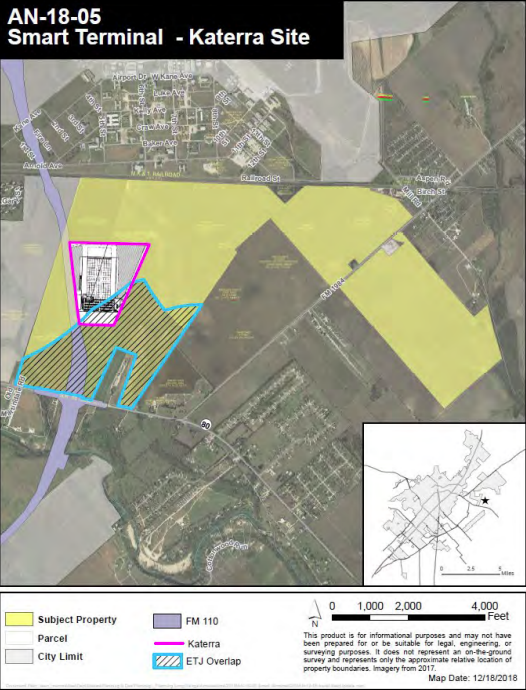
Council briefed on Katerra, SMART Terminal
Land use, acreage, environmental concerns and property values were all part of a discussion of the Katerra and SMART Terminal developments the San Marcos City Council held Tuesday afternoon.
During a workshop meeting, Assistant City Manager Steve Parker gave a presentation on the developments and the acreage where they will be located, which is up for annexation and rezoning by the city of San Marcos. Parker’s presentation was on approximately 734 acres of land along State Highway 80 and Farm to Market Road 1984. Initially, the city was looking to annex more than 900 acres, but part of the acreage lies in a disputed area that appears to be part of the city of Martindale’s extraterritorial jurisdiction (ETJ) and the developer has removed the disputed acreage from his annexation request.
“We’re still in discussions with the city of Martindale related to the ETJ issue,” Parker said, noting that Martindale city officials “seem open to discussions of an ETJ swap.”
Parker also noted the benefits San Marcos could see from annexing the property, including control over building code, fire code and flood prevention regulations, as well as land use control and a potential $3 billion to $4 billion added to the city’s property tax rolls.
Council members Mark Rockeymoore and Saul Gonzales asked if the annexation and planned developments would affect property values nearby; Parker said he could not give a definite answer, but the projected $3-4 billion in his report would be from the property at the SMART Terminal.
As for zoning the land, which the SMART Terminal developer has said needs to be Heavy Industrial to accommodate the rail park, Parker said there is not much difference between light industrial and heavy industrial. Both zoning designations allow impervious cover up to 80 percent, outdoor storage and light industrial uses, and water quality standards apply to both. However, with Heavy Industrial, some land uses — including urban farming, professional offices and emergency clinics — are prohibited.
“It doesn’t mean that we’re going to include some of the things related to wrecking yards, junkyards, that kind of thing,” Parker said.
Working with the developer, Parker said, the city devised a list of proposed prohibited land uses including auto wrecking yards; the manufacture of acid, gas, carbon batteries, iron or steel; the manufacture or storage of explosives or fertilizer; the manufacture of paint, lacquer, oil, turpentine, varnish, enamel, rubber, glucose or dextrin; and other activities that could be environmentally hazardous or would create noxious smells or a lot of noise, Parker said.
“We feel good about the recommendation of the prohibited land uses,” he told council.
Some land uses Parker said the city would like to see considered for portions of the land are professional offices, a hotel, dining, vehicle repair or maintenance, building material sales and a daycare.
Council member Lisa Prewitt said she would like to see land set aside for urban farming to make sure there is always fertile, productive land within San Marcos or its ETJ.
“Let’s think locally and make sure we have land,” she said.
Parker and other city staff also addressed drainage and watershed issues, which the SMART Terminal developers have said they would work on along with neighboring entities, including the San Marcos Regional Airport and Gary Job Corps Center. Parker said the developer has agreed to enact 70 percent total suspended solid removal — the standard required in the city’s recharge zones.
The developer will have to conduct a traffic impact study, Parker said, to determine changes that will need to be made to adjacent roadways like Highways 80 and 21. Moreover, Parker said, Farm to Market Road 110 will be available shortly after the Katerra manufacturing facility and SMART Terminal come online.
Katerra is supposed to add 35 trucks per day to traffic near the development, but that will decline after the rail terminal is brought online.
The rail terminal, in turn, is expected to add between one and three trains per week to current railway traffic, the SMART Terminal developer has said. He explained to council that cars will be added to trains at the rail park, and all switching and connecting will take place at the rail park to avoid train stoppages at crossings in town.
Council discussed the possibility of a Chapter 380 economic development agreement with the SMART Terminal developer — similar to one the city already has with Katerra, the manufacturing facility expected to be the rail park’s first customer — in executive session but took no action in open session.
The proposed annexation, rezoning and construction of the Katerra facility — a factory where construction elements will be manufactured — and the SMART (San Marcos Air, Rail and Truck) Terminal industrial rail park has stirred concerns from residents of both Martindale and San Marcos. Residents of the Blanco River Village neighborhood and residents of the Martindale ETJ near the proposed development have raised questions about traffic, noise, runoff, flooding and general quality of life issues. A petition on Change.org in opposition to the SMART Terminal, Katerra and any other development on the land has garnered 135 signatures as of press time. The reasons given for opposition include unsustainable development, gentrification, environmental concerns, “unwanted culture,” the lack of unionized and worker-owned businesses in San Marcos, and the lack of long-term affordable housing in San Marcos. A group of Brown Berets were at City Hall on Tuesday to protest the development.











